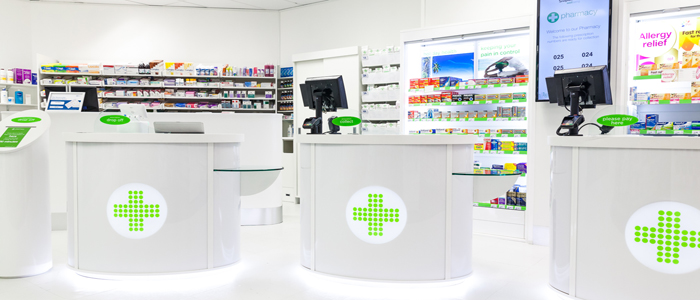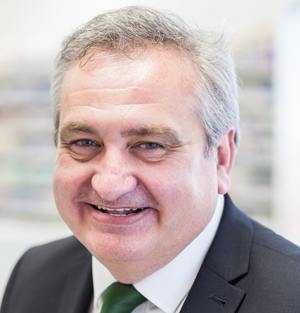Superdrug turns its focus to healthcare
In Retail & merchandising
Follow this topic
Bookmark
Record learning outcomes
The public’s growing interest in wellbeing and health has caught the attention of the UK’s second largest health and beauty chain
In its 50th year, and well established as the UK’s number two beauty retailer, Superdrug has a strong reputation for value to the customer positioned in busy town centre locations. Now, says healthcare director Steve Gray, the chain wants to extend its model to ramp up its impact on the high street for healthcare. It seems like the groups’s 200 pharmacy teams could be central to this mission.

Superdrug stores are having a makeover. Almost 500 of the chain’s 860 shops have recently been refitted, at a cost of £40 million, according to The Sunday Times. All of the portfolio will have had a face lift by the end of the year says Gray. Part of this process is the launch of three concept store models – an affordable and accessible beauty treatments salon store in Cardiff, community pharmacies located in doctor’s surgeries, and, significantly, a wellbeing format store that aims to up the impact of pharmacy in Superdrug and capture the emerging trend for health improvement.
With hard economic times hopefully disappearing and a new managing director, Peter McNab at the helm, it looks like Superdrug is now serious in its search for ways to take a bite from long term UK rival Boots, with healthcare a growing part of the picture.
Wellbeing launch
Superdrug’s first wellness pilot store was launched last month in a shopping centre in the north Oxfordshire market town of Banbury. In charge of healthcare strategy, Steve Gray spoke to P3 about the company’s plans, happening under the watchful eye of owners AS Watson, the international health and beauty retailing group.
 The health side of health and beauty has always been a part of both companies, he says. ‘Healthcare has been a heritage for us: AS Watson [the founder] was a pharmacist and our first Superdrug store was a dispensary. But we felt that healthcare was a real opportunity, in our brand DNA and one that maybe had been a little neglected in the past.’
The health side of health and beauty has always been a part of both companies, he says. ‘Healthcare has been a heritage for us: AS Watson [the founder] was a pharmacist and our first Superdrug store was a dispensary. But we felt that healthcare was a real opportunity, in our brand DNA and one that maybe had been a little neglected in the past.’
As for many other retailers, bold moves are now being required to survive tricky trading conditions. There is a significant amount of investment involved that’s been hard-won: ‘Over the last few years Superdrug has had a bit of a struggle and had a bit of a lack of investment across the portfolio. But we have a new strategy in place with a new management team. We’ve had quite a turnaround in the past couple of years – and had good sales growth and a good profit growth. That’s meant that our shareholders – AS Watson – are now investing in us and hence we can develop stores like this.’
All of Superdrug’s 860 stores will have been completely refitted by the end of next year, he says. ‘We are about half way through – it’s a lot of capital investment, but because we are getting a return on it and our shareholders believe in our vision and our strategy, they are prepared to invest.’
And ambitions are high, with hopes that the pilot or at least elements of it, will be important for the healthcare strategy for the whole porfolio. ‘We don’t want to just catch up, we want to overtake the marketplace and provide something new and different. How can healthcare work on the high street? We think that we’ve done that here.’
Â
Future models for pharmacy services – who pays?
Part of the wellbeing model adopted by Superdrug is a range of services that can be commissioned, or paid for by customers. Steve Gray says that trends data backs up this approach – that customers are now more likely to pay for aspects of their healthcare: ‘I think people’s propensity to pay is changing. If you look at privately paid for healthcare, what consumers pay for themselves, is growing at about two or three times the rate of public spend in healthcare. The general public, on average, is spending about six per cent more on health and wellbeing products and services than they did in the previous year.’
This may be because it is slightly more difficult to get products and services from the NHS, he suggests, but also because attitudes are changing. ‘People are a lot more involved about their health conditions – what keeps you healthy and how you can lead a fuller life. I think they are prepared to pay a bit more money on that, and it’s a growing market.’
New concept
A typical Superdrug store has a 70/30 split between beauty and healthcare, says Gray. In the Banbury store this is 60/40, giving a greater proportion of floor space to healthcare. Beauty is at the entrance to the store, and customers are led through beauty to healthcare and to several large consultation rooms and a pharmacy counter. Lit information boards offer clear signage, and a user- friendly approach to navigation – for example the skincare section is signed ‘stunning skin’, eye care is ‘brilliant eyes’ and children’s health is signposted ‘kiss it better’. Retail categories have been rationalised, explains Gray. ‘We have also extended our range to go into healthy lifestyle and wellbeing and we have extended our vitamins and supplements ranges quite significantly. It’s not just about treatment or managing your medicines. That fits with what our customers want, but also what our brand is about.’
We don’t want to just catch up, we want to overtake the marketplace and provide something new and different
From the well-fitted large consultation rooms pharmacists and a nurse offer services such as flu vaccination and an ED service. Other practitioners, including a chiropodist and chiropractor, Marie Curie nurses and Lighter Life also run clinics and groups from the consultation rooms. Local research found that Banbury has a birth rate that’s 10 per cent higher than the national average – so the store has a large baby care section and is hosting baby clinics as well to tailor to the specific needs of the local community.
A key move has been to increase staffing in pharmacy to allow staff to give more time to customers in store who need healthcare and wellbeing advice. ‘We have changed the staffing model. We have doubled the amount of staff team hours in the store, because we don’t want our pharmacists spending all their time with their head over the bench just doing prescriptions. Their real value is talking to customers and patients.’
‘In my view pharmacists should be one of the most accessible clinicians in the NHS arena. We want our pharmacists and our pharmacy teams to be out on that shop floor speaking to customers and advising them,’ says Gray.
Â
Pharmacy out on the shop floor
Healthcare is not just behind the pharmacy counter, says Christine Burbage, superintendent pharmacist for Superdrug. ‘We want our pharmacy teams to come out from the shop counter and engage with the shop floor. We have recruited more staff into this particular location so that we can do that.’
Having a second pharmacist is an investment, but while there usually has to be a balance to be struck between doing the day job on pharmacy and services, a second pharmacist can be doing services or interacting with patients or customers. Counter staff have received extra training to allow them to interact in a different way with customers, in skincare for example. ‘This is about bringing the pharmacy team out to where the people are. We want them to ask for advice. People might be shopping for other things, and we can get messages across in a different way,’ she says.
Success criteria
Is the expectation that the wellbeing model will be rolled out? ‘It depends on the level of success. We have earmarked the 200 stores that we will roll out the learnings from here into, whether that’s services, the people structure, the products or the category mix, or a combination of all of those. If the whole concept works, then we will roll out complete new stores.’ Plans for a second store, opening in Watford in July, are underway, he says.
Will higher staffing levels required for the new model pay off? ‘We don’t want the lowest cost to operate, we want the highest service to operate.’ ‘We’re quite confident that with  how we’ve structured the teams and the amount of products and services that we’ve brought in that it will pay for itself. I certainly hope that it does. ‘We know from a service point of view that it will work, but we are a business and we’ve got to make sure that it works commercially too. If we are being straight about it – does it pay for itself?
how we’ve structured the teams and the amount of products and services that we’ve brought in that it will pay for itself. I certainly hope that it does. ‘We know from a service point of view that it will work, but we are a business and we’ve got to make sure that it works commercially too. If we are being straight about it – does it pay for itself?
Success in retail will be a significant measure for the model, he says. ‘We think – if we’ve managed to get it right – we will have managed to condense the ranges and maintained sales. Only time will tell. We think we’ve cut off the tail of some of our categories, but we’ve got the vast majority of the range and the vast majority of turnover and profit.’
And will beauty sales be affected? ‘We haven’t budgeted for a decline in beauty sales, because we think that footfall will go up,’ he says.
Does the service-focused model increase the potential for service commissioning from Superdrug pharmacies? Gray certainly feels that this is something that should develop more across pharmacy generally. ‘We all know that pharmacists can do a lot more than they currently do; while I think that the progressive CCGs do see that, I’m not sure that all GPs and all CCGs do.’
There is a need to develop the perception of pharmacy as a whole, but it’s a ‘double whammy’ for Superdrug he says. ‘We also need to change the perception of Superdrug, as we are not seen necessarily as a pharmacy company. That’s why we’ve taken the wellbeing approach to try to take it on to the next level.’
